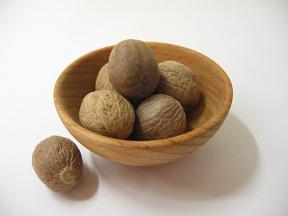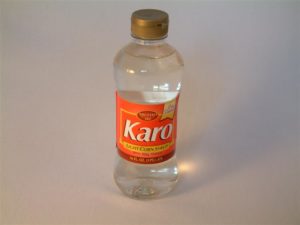1. baking soda –
2. baking powder
3. Cornstarch
4. yeast
5. flour
6. corn flour
7. corn meal
8. Salt
9. pepper -white and black
10. Sugar
11. confectioner’s sugar
12. brown sugar
13 light corn syrup
14. vanilla extract
15. ground cinnamon
16 whole nutmeg
17. ground cloves
18. Onion salt
19. dried chopped or minced onions
20. dried basil
21. dried oregano
22. chili powder
23. dry mustard
24. paprika
25. thyme
26. tarragon
27. dried dill
28. bay leaves
29. poultry seasoning
30. beef, chicken and vegetable bouillon
31. cream of tartar
32. unseasoned bread crumbs
33. unsweetened cocoa powder
34. unsweetened baking chocolate
34. chocolate chips
13) Light Corn Syrup
A thick sweet syrup which comes in both light and dark varieties, made from processed cornstarch. Light corn syrup has been clarified, while dark corn syrup has had coloring and caramel flavoring added. So you don’t need dark corn syrup. I made some homemade Worcestershire sauce last week and it called for light corn syrup and molasses.
Ingredient :
Used in cookie, caramel, glazes, sauces, cake icing, pies, candy
Season: available year-round
Substitutions: 1/2 cup sugar + 2 tbsp water = 1/2 cup light corn syrup; 1/2 cup honey = 1/2 cup light corn syrup
14) Vanilla extract
Vanilla extract is a solution containing the flavor compound vanillin. Pure vanilla extract is made by extracting from vanilla beans in an alcoholic solution. In order for a vanilla extract to be called pure, the FDA requires that the solution contain a minimum of 35% alcohol and 13.35 ounces of vanilla bean per gallon[1]. Double and triple strength vanilla extracts are available. Natural vanilla flavoring contains real vanilla bean but no actual alcohol. Imitation vanilla extract is usually made by soaking alcohol into wood, which contains vanillin.
So, now that you know why winos buy cheap vanilla extract and drink it, I’ll tell you which ones you should buy. Don’t ever buy Imitation vanilla extract, it sucks. Buy the best vanilla you can find. It is cheap and you don’t use much. I even make my own by soaking a couple of vanilla beans in a good vodka for a couple of months. The best store bought vanilla extract I’ve ever had my mother gave me for my birthday. It is Sonoma Syrup Co. Special Blend. Pure Vanilla Bean Extract “crush” Madagascar bourbon & tahitian vanilla with vanilla bean seeds. It is 8 oz she got from the HomeGoods store for $12.99. It has a big, pure flavor and doesn’t water down the things you put it in.
Vanilla is used in pastries, cookies, cakes, sauces, drinks and lots of other stuff. There really isn’t a substitute so you should have some on hand.
15) Ground Cinnamon info from http://www.theepicentre.com/Spices/cinnamon.html
Cinnamon is the inner bark of a tropical evergreen tree. There are many different species, between 50 and 250, depending on which botanist you choose to believe. The two main varieties are Cinnamomum cassia and Cinnamomum zeylanicum. The first, cassia, we will consider separately in its own section. C. zeylanicum is also known as Ceylon cinnamon (the source of the its Latin name, zeylanicum), or ‘true cinnamon’ which is a lighter colour and possessing a sweeter, more delicate flavour than cassia. A native of Sri Lanka (formerly Ceylon) the best cinnamon grows along the coastal strip near Colombo.
In ancient Egypt cinnamon was used medicinally and as a flavouing for beverages, It was also used in embalming, where body cavities were filled with spiced preservatives. In the ancient world cinnamon was more precious than gold. This is not too surprising though, as in Egypt the abundance of gold made it a fairly common ornamental metal. Nero, emperor of Rome in the first century AD, burned a years supply of cinnamon on his wife’s funeral pyre — an extravagant gesture meant to signify the depth of his loss.
Cinnamon was known in medieval Europe, where it was a staple ingredient, along with ginger, in many recipes. Since most meals were prepared in a single cauldron, casseroles containing both meat and fruit were common and cinnamon helped bridge the flavours. When crusaders brought home sugar, it too was added to the pot. Mince pie is a typical combination of this period which still survives.
The demand for cinnamon was enough to launch a number of explorers’ enterprises. The Portuguese invaded Sri Lanka immediately after reaching India in 1536. The Sinhalese King paid the Portuguese tributes of 110,000 kilograms of cinnamon annually.
The Dutch captured Sri Lanka in 1636 and established a system of cultivation that exists to this day. In its wild state, trees grow high on stout trunks. Under cultivation, the shoots are continually cropped almost to ground level, resulting in a low bush, dense with thin leafy branches. From these, come the finest quills.
Cinnamon is good for a lot of things. It has been proven to lower cholesterol and blood pressure. I like to add a teaspoon to my cereal in the morning for medicinal reasons. Here again it pays to get the best. I buy cinnamon sticks from Sri Lanka and grind them myself in the food processor as needed. If you get pre-ground cinnamon it contains large amounts of by-products like sawdust.
16) Whole nutmeg
I don’t know why, but I hate nutmeg. Unfortunately it is an important ingredient in a lot of recipes. I think I don’t like it because it is often over used or used in too large a quantity. Buy the whole nuts that come with a little grater and store the nut in the grater. It will last forever. Or get a bottle of nuts and use your microplane to grind it when needed.
17) Ground cloves
Don’t buy pre-ground, buy whole and grind it as needed. It will be fresher and last longer. Looks like you will need a dedicated coffee grinder for spices and a microplane. We’ll talk about that later.
The clove tree is an evergreen which grows to a height ranging from 10-20 m, having large oval leaves and crimson flowers in numerous groups of terminal clusters. The flower buds are at first of a pale color and gradually become green, after which they develop into a bright red, when they are ready for collecting. Cloves are harvested when 1.5-2 cm long, and consist of a long calyx, terminating in four spreading sepals, and four unopened petals which form a small ball in the centre.
According to FAO, Indonesia produced almost 80% of the world’s clove output in 2005 followed at a distance by Madagascar and Tanzania.
Cloves can be used in cooking either whole or in a ground form, but as they are extremely strong, they are used sparingly. The spice is used throughout Europe and Asia and is smoked in a type of cigarettes locally known as kretek in Indonesia. The largest brand of kreteks in the United States is Djarum, who sells the iconic Djarum Black. Cloves are also an important incense material in Chinese and Japanese culture.
Cloves have historically been used in Indian cuisine (both North Indian and South Indian)as well as Mexican cuisine (best known as “clavos de olor”), where it is often paired together with cumin and cinnamon.[1] In the north Indian cuisine, it is used in almost every sauce or side dish made, mostly ground up along with other spices. They are also a key ingredient in tea along with green cardamoms. In the south Indian cuisine, it finds extensive use in the biryani along with cloves dish (similar to the pilaf, but with the addition of local spice taste), and is normally added whole to enhance the presentation and flavor of the rice.
Toxicity
Large amounts should be avoided in pregnancy. Cloves can be irritating to the gastrointestinal tract, and should be avoided by people with gastric ulcers, colitis, or irritable bowel syndrome. In overdoses, cloves can cause vomiting, nausea, diarrhea, and upper gastrointestinal hemorrhage. Severe cases can lead to changes in liver function, dyspnea, loss of consciousness, hallucination, and even death. The internal use of the essential oil should be restricted to 3 drops per day for an adult as excessive use can cause severe kidney damage.
I don’t use cloves very often, mostly for decorations, because they smell great stuck in an orange. I’ve seen them used stuck in a ham for presentation, but if you are going to drop anything from this list, cloves are a good candidate.
You may have noticed that I changed a few of the ingredents on the list from yesterday. I dropped powdered ginger. I’ve never used it. I know it is used in cookies and oriental cooking but I prefer fresh. I also added minced onions and onion salt. Well go over their uses tomorrow.
Have a good day, we’ll be cooking soon.
Jughandle


